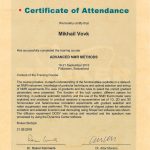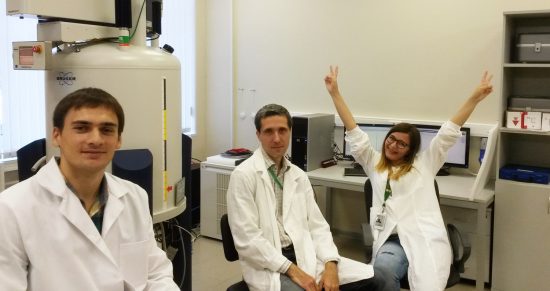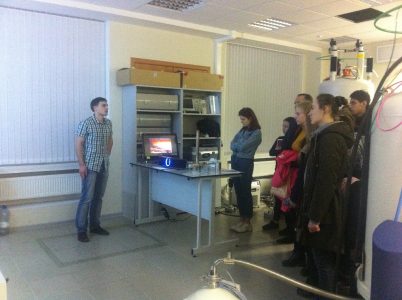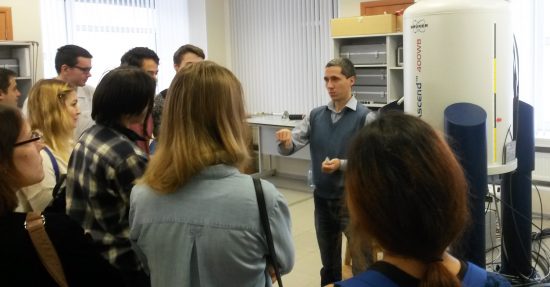
Обзорная экскурсия для студентов-бакалавров 4 курса химического факультета. П.М. Толстой провел вводную лекцию для наших посетителей, М.А. Вовк, А.С. Мазур, С.М. Сухаржевский провели демонстрацию ЯМР, ЯКР и ЭПР спектрометров.
Tag Archive for Вовк
Экскурсия
Экскурсия для студентов
Трофеи стажировки
Михаил Вовк успешно прошел курс «Advanced NMR methods» в рамках которого освещались: применение ямр термометров; настройка и применение shaped pulses для селективного возбуждения, адиабатической инверсии и развязки; 1D, 2D, 3D гомоядерные и гетероядерные корреляционные эксперименты с применением градиентных систем.
Конгресс Университета Арктики
В рамках Конгресса Университета Арктики (12-16.09.2016, Санкт-Петербург; http://www.uarctic.spbu.ru/) П.М. Толстой выступил с докладом о работе Научного парка СПбГУ на примере РЦ «Магнитно-резонансные методы исследования». Был организован телемост с ресурсным центром, во время которого специалисты А.С. Мазур и М.А. Вовк отвечали на вопросы о текущей работе и выполняемых проектах.
Экскурсия
День открытых дверей
Экскурсия для студентов ЛЭТИ
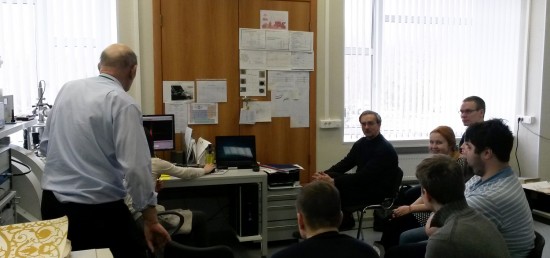
В рамках экскурсии специалистом РЦ Михаилом Вовк продеманстрировано оборудование РЦ МРМИ для решения исследовательских задач методами спектроскопии ЯМР, Станиславом Михайловичем Сухоржевским и Екатериной Гребенюк проведена демонстрация работы на ЭПР спектрометре Bruker Elexsys E580, освещены некоторые особенности спектроскопии ЭПР и областей применения данного метода исследования.
Экскурсия для физиков
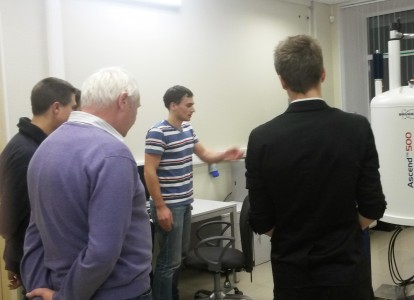
Михаил Вовк проводит обзорную экскурсию в РЦ для студентов физиков первого года обучения.
J. Phys. Chem. B, 2015, 119, 13358-13366
Приятным сюрпризом для коллектива РЦ было увидеть публикацию в соавторстве с сотрудниками на обложке «Journal of Physical Chemistry B».
S.O. Rabdano, A.V. Donets, M.A. Vovk, D.Michel, V.I. Chizhik
“ “Hydration Shells” of CH2 Groups of ω‑Amino Acids as Studied by Deuteron NMR Relaxation”
J. Phys. Chem. B, 2015, 119, 13358-13366
DOI:10.1021/acs.jpcb.5b06584
Hydration phenomena play a very important role in various processes, in particular in biological systems. Water molecules in aqueous solutions of organic compounds can be distributed among the following substructures: (i) hydration shells of hydrophilic functional groups of molecules, (ii) water in the environment of nonpolar moieties, and (iii) bulk water. Up to now, the values of hydration parameters suggested for the description of various solutions of organic compounds were not thoroughly analyzed in the aspect of the consideration of the total molecular composition. The temperature and concentration dependences of relaxation rates of water deuterons were studied in a wide range of concentration and temperature in aqueous (D2O) solutions of a set of ω-amino acids.
Assuming the coordination number of the CH2 group equal to 7, which was determined from quantum-chemical calculations, it was found that the rotational correlation times of water molecules near the methylene group is 1.5−2 times greater than one for pure water. The average rotational mobility of water molecules in the hydration shells of hydrophilic groups of ω-amino acids is a bit slower than that in pure solvent at temperatures higher that 60 °C, but at lower temperatures, it is 0.8−1.0 of values of correlation times for bulk water. The technique suggested provides the basis
for the characterization of different hydrophobic and hydrophilic species in the convenient terms of the rotational correlation times for the nearest water molecules.
Dalton Trans. 2015, accepted
A. S. Antonov, A. F. Pozharskii, V. A. Ozeryanskii, A. Filarowski,
K. Yu. Suponitsky, P. M. Tolstoy, M. A. Vovk
“Ring Lithiation of 1,8-Bis(dimethylamino)naphthalene: Another Side of the ‘Proton Sponge Coin’”
Dalton Trans., 2015, accepted
DOI:10.1039/C5DT02482J
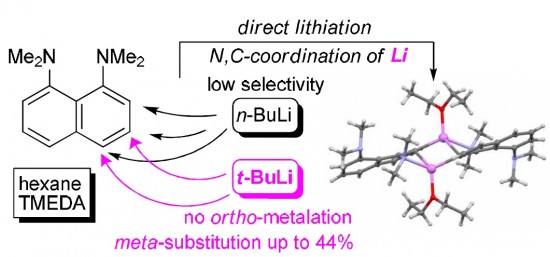
It has been found that 1,8-bis(dimethylamino)naphthalene (DMAN), unlike N,N-dimethylaniline, undergoes ring metallation in n-BuLi–TMEDA–Et2O system with low selectivity and in poor total yield. The situation is significantly improved in t-BuLi–TMEDA–n-hexane system when 3- and 4-lithium derivatives become the only reaction products in good yield. The formation of 3-Li-DMAN is especially fortunate since no method of direct meta-functionalization of DMAN has been known to date. The relative stability and structure of DMAN lithium derivatives have been examined with the help of X-ray and multinuclear NMR measurements as well as DFT calculations.

